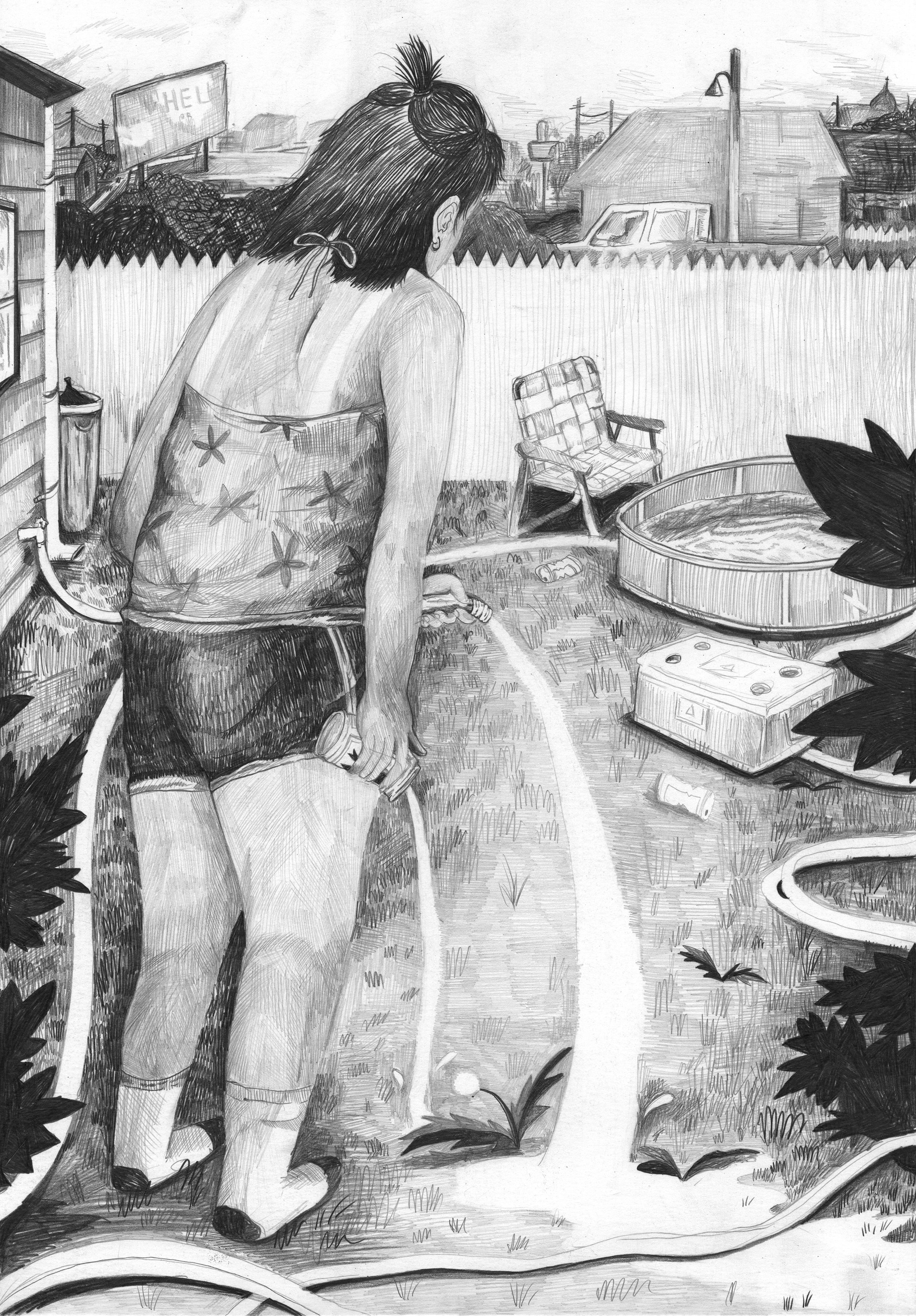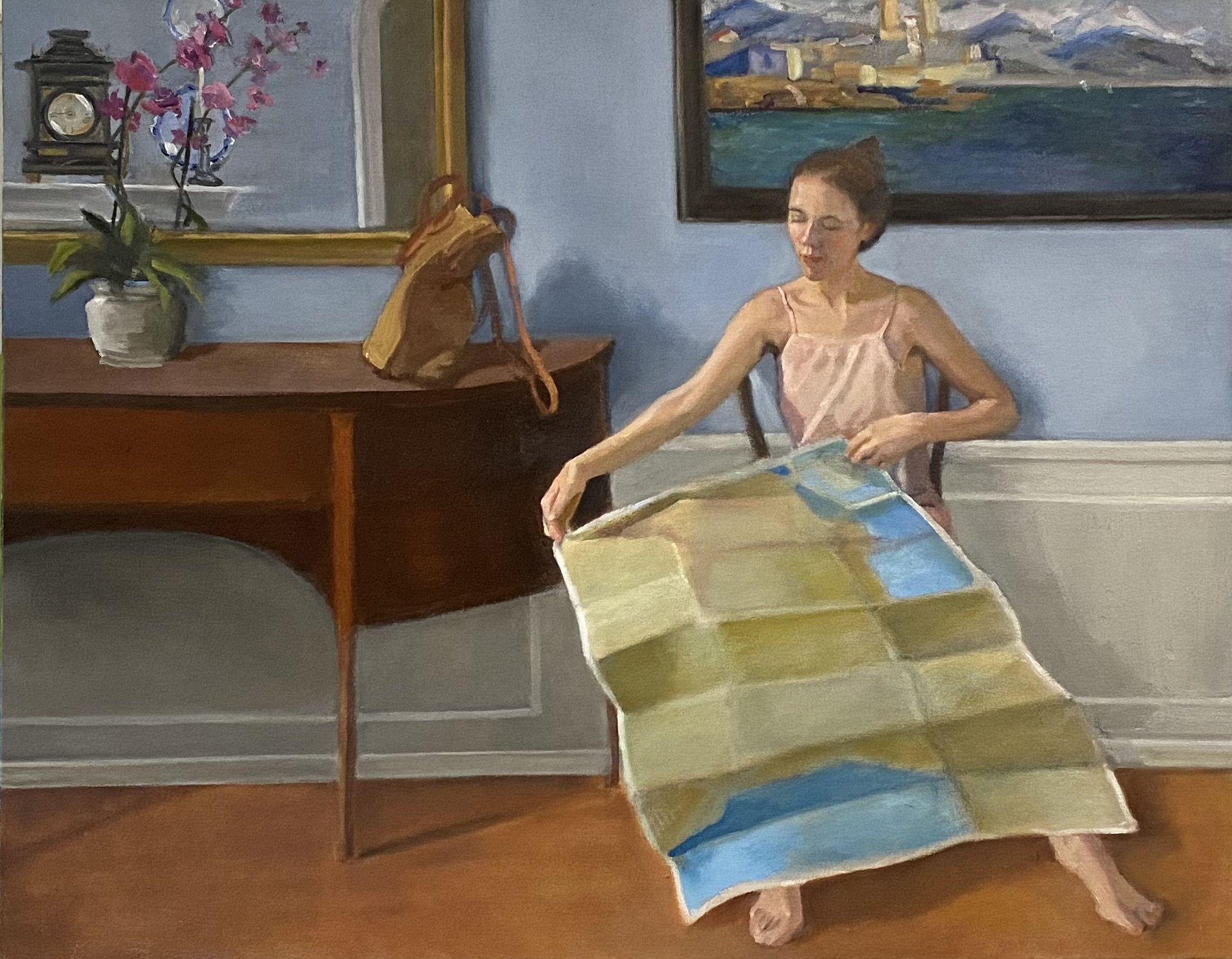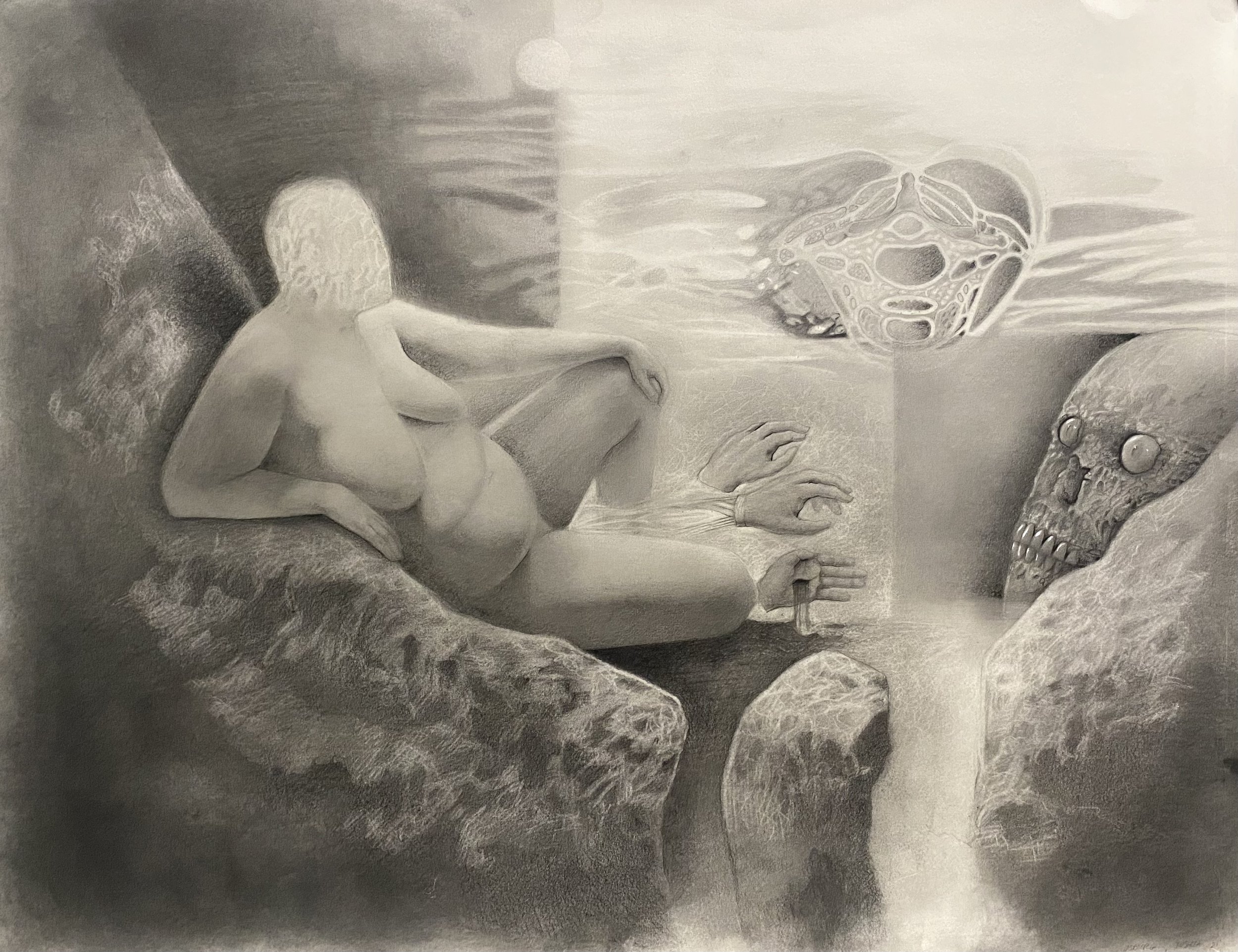Tell Me A Story Award Winners
Tell Me a Story, November 18 - December 31, 2022, includes works of various styles and mediums that lead the viewer toward or through a narrative juried by Caitlin Winner. Based on the juror’s ranking for 1st, Mary Climes’s “Split Streams”, 2nd, Sarah Blumenfeld’s “Departure”, and 3rd, Joshua Osburg’s “Twin Mothers”. We sent these artists questions based on their pieces, with a more in depth look at Mary Climes 1st place winning piece, “Split Streams.”
What kind of emotions did you want portrayed through your piece?
Mary - “Split Streams plays on feelings of isolation, apathy, and melancholic humor, all set within a dazing hot summer day in suburbia. The figure is positioned to look boxed in within this small backyard, performing a meaningless task, and visually mimicking urinating. i wanted to portray a particular feeling of summer bummer.”
Sarah - “My painting “Departure” depicts human restlessness, anticipation, the beginning of a seismic change. “
Joshua - “I think the emotions I wanted to portray in my piece were that of the moment. I don’t go in to a painting or drawing thinking of anything particular emotion. I believe there are plenty of emotions stuck in my subconscious, that I have not yet been able to experience and being in the moment frees those emotions so they can be expressed. “
Was the piece on the spot or a random idea, or was it planned out and if so how did you plan it out?
Mary - “My work is a careful composition of art historical and cartooning references to further an emotional and narrative motives. Here I portray a specific moment of contemplation for a faceless figure in a space littered with iconography. I render familiar objects like the folding chair, beer cooler, trash can, picket fence, and dandelion around the single figure in order to situate them in this private (and public) space. I reference religious artwork, especially representations of women in Catholicism. Specifically, the icon of women in the walled garden is seen often in religious art. Eve’s being cast from the Garden of Eden and the Annunciation of the Virgin Mary are two recurring scenes. These are always settings of fate for the women, where the distinction of sinner and saint is questioned. The looming sign of hell is above the figure, while a hopeful symbol of a wish lays at the feet. The hose and beer can act together as the visual gag: marking their territory, watering weeds, and, while one penis reference is good, two is better.”
Sarah - “As an aphantastic, or mind-blind artist, I always have to plan the various pieces that will fit together in my art and wait patiently as each work evolves conceptually. I have eyesight, but I have never had a mind’s eye that could visualize. I can conceive of things, verbally or spatially, but I only SEE them if I draw them or have an actual visual reference. Once I look away from an image, that image, shape and color, etc. is lost to me, except as how I have stored it in language. It is a strange disability. It makes me a strange kind of creator and an inconsistent narrator. I have no clear idea what my own painting will look like in advance of creating it. My paintings undergo great planning and harsh evolutions. This painting began one day when I studied a Degas painting of a dancer. The model posed for me using a map in place of the dancer’s skirt. As she sat for me, she described a months-long solo trip she was embarking on to Mexico. Although I composed her surroundings from my existing dining room, she evokes for me the memory of escaping my own home at age 16. This painting depicts a calmer situation, although I feel it channels a universal impulse for changing one’s life.”
Joshua - “None of my pieces are planned out in the way of following through with a preliminary on to the finished piece. Most of the time, it begins as curiosity in understanding the human form. I will begin as if it is a classical drawing and something within myself leads me on a imaginary path.”
Does your art tell a story more personal to you through experiences, and if you can share how? If it doesn't, who or what audience did you create this story for?
Mary - “Yes, I grew up surrounded by images within the Catholic church and was told of the ways women are supposed to behave in the eyes of religion. This manifests in the melancholic and apathetic nature that resonates in the figure. I hope that this image can speak to a larger sense of feelings of isolation, confinement, and seemingly hollow sense of pondering everyday tasks.”
Sarah - “This piece begins to tell the story of a teenage girl who left a troubled life, alone, to live across the world. I found a home for more than a year on a small rabbit farm in a foreign country, with a new family, speaking a new tongue, before the advent of email or internet. The same girl never returned home. The painting depicts the remarkable human power to plan an escape, to adapt and change, to make a new home, and to become the hero of your own story when life demands it. However, every object is in its place in this painting. It more reflects me in my life now, remembering that girl. If I were to paint it again, I would allow it to contain the chaos of the girl’s life. I believe I would re-integrate that girl into this one more fully.”
Joshua - “My work represents what exists in the shadow of self. Intuition and my willingness to proceed in the depths of my mind to uncover the impregnated ideas of what this world means to me from the environments and experiences I’ve lived.”
Is art an outlet for your emotions and/or does it help you embrace and tell a tale of such associated feelings with your pieces? And how long have you been using art that way?
Mary - “Yes, my work helps me process complex feelings of my childhood, my relationship with womanhood, and “bad” behaviors. Not only do I concern myself with these crucial topics, but humor is equally important to me. Humor is a way to process and recast events, and it can provide as rich and complex of a response as drama. My first memory of making art was of 2nd grade in Catholic school. I remember feeling proud of a drawing I had made of the Virgin Mary, but it wasn’t until I was called to Sister Margot’s office that I knew something was wrong with it. I had drawn her with a large cleavage. Appalled, the sisters asked how I could possibly do this to the Lord’s mother. I replied, “I just wanted her to look cool!” I don’t see my art practice as dissimilar to that moment.”
Sarah - “Art for me now is an amazing escape from ordinary life and a fantastic way to grow my powers of vision and memory. I still cannot see what I am about to do, but I can predict my mark-making with greater certainty! I remember as a little girl, I used to make one recurring drawing, of the back of a girl’s head, with long hair. I would gradually erase her hair, giving her new haircuts. I remember being surprised with each cut, because of course, in retrospect, I could not picture it. In time I became a writer, a poet, an attorney, a mom and a teacher, long before I ever made another drawing for myself. At age 50 I stumbled upon what was missing and earnestly set about learning everything about imagery and art. In my studio, every creation is literally a surprise.”
Joshua - “Art is not an escape, but a magnifying glass in to what it is to me. Perhaps, it is an outlet in the way that I get to share what it is to be human.”
More From Mary -
- Is grayscale your typical style? If not, was there a purpose for that palette in your story? I often use graphite pencils and graphite powder within my work. I find that the medium is direct and honest. It is an uncomplicated, iridescent, and a messy material. There is a humility to drawing, and graphite allows me to transform this way of making an image into a complex composition. These complexities can be amplified by scale, edition, and movement. Working with graphite is like cartooning in this way, there is simplicity made complex by history and hand.
- With such a palette usually, contrast helps the layout lead the eye, does your piece use that and what points did you want the eye to land on? Contrast is helpful when it comes to direction and readability with a monotone palette. The composition and organization of objects within space also aid in revealing a movement of time within the narrative. The intention for my work is to be legible. I use iconography and cartooning as a legible language, then further complicate the objects by their context and juxtaposition within the composition.



